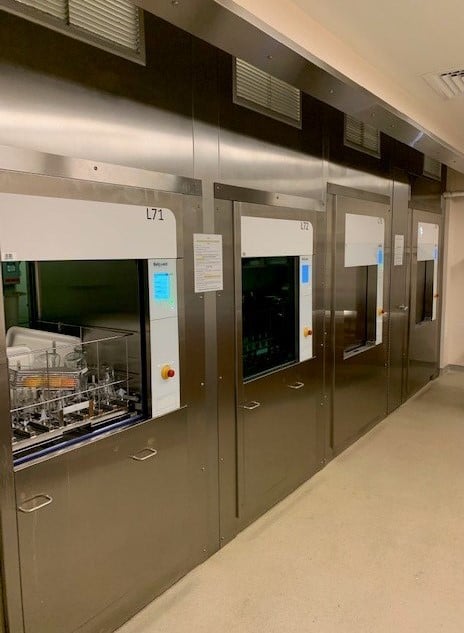A Lot of Water, Not Down the Drain
 Glassware in the laboratories throughout the Aaron Lazare Research Building are clean and greener than ever.
Glassware in the laboratories throughout the Aaron Lazare Research Building are clean and greener than ever.
In August, the UMass Chan Facilities Management team completed a five-month, $2.5 million project, to replace all of the glass washing and sterilization systems in the LRB. The new equipment uses less electricity and will save an estimated 3.3 million gallons of water a year.
“The old equipment was 19 years old, so it was time,” said Karen Lepkowski, the maintenance manager who coordinated the project. “The technology of these systems has come a long way. The water savings is huge, and the operating costs are less.”
A total of 16 glass washing machines and 17 autoclaves were replaced. The work was done in phases, with equipment on three floors of the building replaced in each phase. “We planned it that way so there would always be enough capacity for glass washing and sterilization for the whole building,” Lepkowski said. “Those machines are running all day long.”
Sterilizing glassware for use in the laboratories is a two-step process. First, glassware goes into a washing machine that utilizes high-pressure jets and alkaline detergents. Then the washed glassware goes to an autoclave for high-temperature sterilization.
The old systems used potable water drawn from the city’s municipal water system. After each wash and sterilization cycle, the used water went down the drain and out to the regional waste water system.
The new glass washers do consume some potable water, although far less than the old machines, but the new autoclaves do not use potable water. They get water from the chilled water system in the LRB. Chilled water is produced by the school’s power plant and circulates throughout the campus for climate control in the buildings. After each sterilization cycle, water used by the new autoclaves is recaptured and drains back into the chilled water system, to be processed through the power plant and recirculated.
The old equipment consumed approximately 4.16 million gallons of potable water a year. The new washers and autoclaves are projected to consume just 828,000 gallons of potable water, a savings of 3.3 million gallons annually. The new systems also use less electricity, Lepkowski said, saving about $60,000 in operating costs annually.
The new equipment was manufactured and installed by Belimed Infection Control, the same company that supplied the sterilization systems in the Albert Sherman Center. “We have eight years of experience with the Belimed equipment in the Sherman Center now, and I’ve been pleased with its performance,” Lepkowski said.
